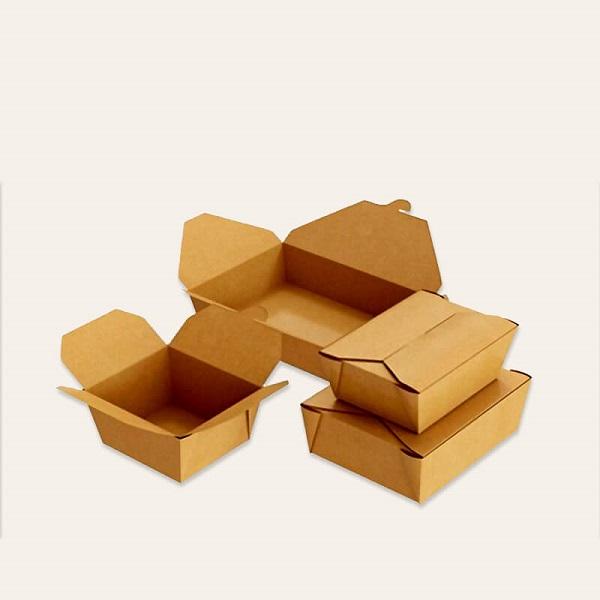Top Design Tips for Cardboard Takeout Boxes

Personalized Cardboard boxes are a staple in the food industry, valued for their affordability, sustainability, and versatility. A well-designed takeout box not only ensures food stays fresh and secure but also enhances the customer experience and reinforces brand identity. Whether you’re a restaurant owner, food truck operator, or packaging designer, these top design tips will help you create functional, attractive, and eco-friendly cardboard takeout boxes that stand out.
1. Prioritize Functionality
The primary role of a takeout box is to protect food during transport while maintaining its quality.
-
Secure Closures: Use foldable flaps, tuck-in tabs, or interlocking designs to ensure the box stays closed. For example, clamshell boxes with sturdy hinges prevent spills.
-
Grease and Moisture Resistance: Apply food-safe, recyclable coatings (e.g., water-based or plant-derived) to handle oily or saucy foods like fried chicken or pasta without compromising recyclability.
-
Ventilation: Incorporate perforations or steam vents for hot foods like pizza or fries to prevent sogginess while keeping the food crisp.
2. Optimize for Food Type
Tailor the box design to the specific food it will hold to enhance functionality and presentation.
-
Compartmentalization: For multi-item meals, include dividers or inserts to keep foods separate, like sushi with sides or combo platters.
-
Shape and Size: Match the box to the food’s dimensions—use shallow boxes for burgers and deep ones for salads to avoid crushing delicate items.
-
Microwave-Safe Features: Use coatings that allow reheating in the box, adding convenience for customers.
3. Enhance Brand Identity
A takeout box is a mobile billboard for your brand, so make it visually appealing and memorable.
-
Vibrant Printing: Use high-quality, eco-friendly inks for logos, taglines, or colorful designs that reflect your brand’s personality. For example, bold graphics on a taco truck’s boxes can attract attention.
-
Minimalist Aesthetics: Opt for clean, modern designs with simple color schemes for a premium feel, especially for upscale restaurants.
-
Interactive Elements: Add QR codes linking to menus, social media, or loyalty programs to engage customers.
4. Focus on Sustainability
Eco-conscious design is a must as consumers and regulations demand greener packaging.
-
Recyclable Materials: Use 100% recyclable or recycled cardboard, ideally FSC-certified, to ensure sustainable sourcing.
-
Compostable Coatings: Replace traditional plastic or wax coatings with biodegradable alternatives like cornstarch-based films.
-
Minimal Material Use: Design boxes with efficient shapes to reduce waste, such as flat-folding boxes that save space and resources.
5. Improve User Experience
Make the box easy and enjoyable for customers to use, enhancing their overall experience.
-
Easy-Open Features: Include tear strips or pull-tabs for quick access without tools.
-
Handles or Grips: Add built-in handles or reinforced edges for easy carrying, especially for larger orders.
-
Stackability: Design boxes with flat tops and sturdy bases to stack neatly during delivery or transport.
6. Incorporate Insulation
Keep food at the right temperature to maintain quality from kitchen to customer.
-
Corrugated Layers: Use corrugated cardboard for natural insulation, ideal for hot or cold foods like pizzas or salads.
-
Double-Wall Designs: For premium takeout, incorporate double-layered walls to retain heat or cold longer, perfect for meal kits or catering.
7. Test for Durability
Ensure the box can withstand real-world conditions without failing.
-
Stress Testing: Simulate stacking, dropping, or tilting to confirm the box holds up during delivery.
-
Weight Capacity: Design for the food’s weight—reinforce bases for heavy items like pasta dishes or family-sized meals.
-
Moisture Resistance: Test in humid or rainy conditions to ensure coatings perform as expected.
8. Stay Trendy and Innovative
Adopt the latest design trends to keep your packaging fresh and competitive.
-
Molded Fiber Inserts: Use pulp-based inserts for a premium, eco-friendly alternative to plastic dividers.
-
Smart Packaging: Experiment with temperature-sensitive labels that indicate food freshness.
-
Cultural Designs: Incorporate local or seasonal themes, like festive patterns for holidays, to connect with customers.
Conclusion
Personalized cardboard food boxes requires balancing functionality, sustainability, and aesthetics. By prioritizing secure closures, food-specific features, and eco-friendly materials, you can create packaging that protects food and delights customers. Add bold branding and user-friendly elements to elevate the experience, and stay ahead with innovative trends like compostable coatings or smart labels. With these tips, your takeout boxes will not only deliver meals but also leave a lasting impression on your customers and the planet.
- Art
- Causes
- Crafts
- Dance
- Drinks
- Film
- Fitness
- Food
- Spiele
- Gardening
- Health
- Startseite
- Literature
- Music
- Networking
- Andere
- Party
- Religion
- Shopping
- Sports
- Theater
- Wellness




